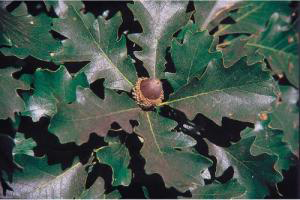Many birds and animals depend on the acorns and foliage of Quercus macrocarpa for food, and the tree for cover.
Photo Credit: © USDA-NRCS PLANTS Database / Herman, D.E., et al. 1996. North Dakota tree handbook. USDA NRCS ND State Soil Conservation Committee; NDSU Extension and Western Area Power Administration, Bismarck.
Quercus macrocarpa
Common Name: bur oak
Plant Functional Group: Deciduous broadleaf
Class > Order > Family: Magnoliopsida > Fagales > Fagaceae
